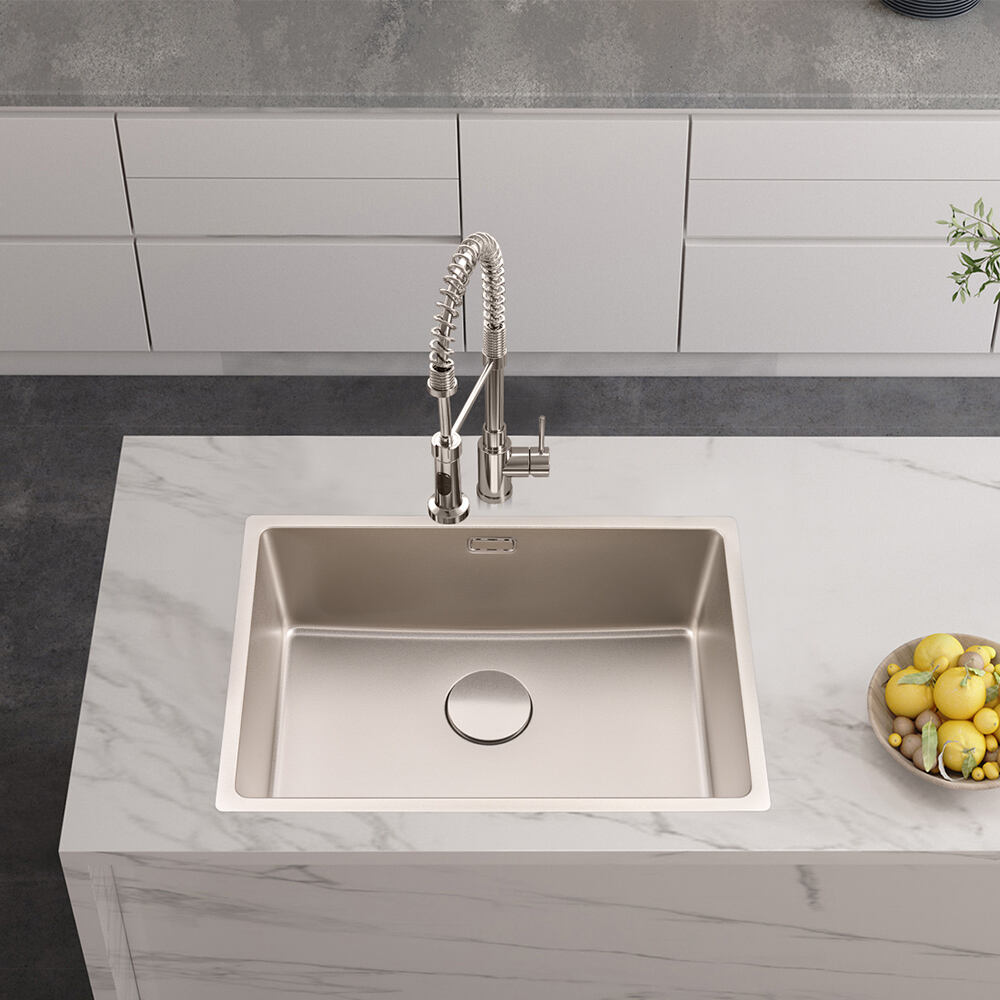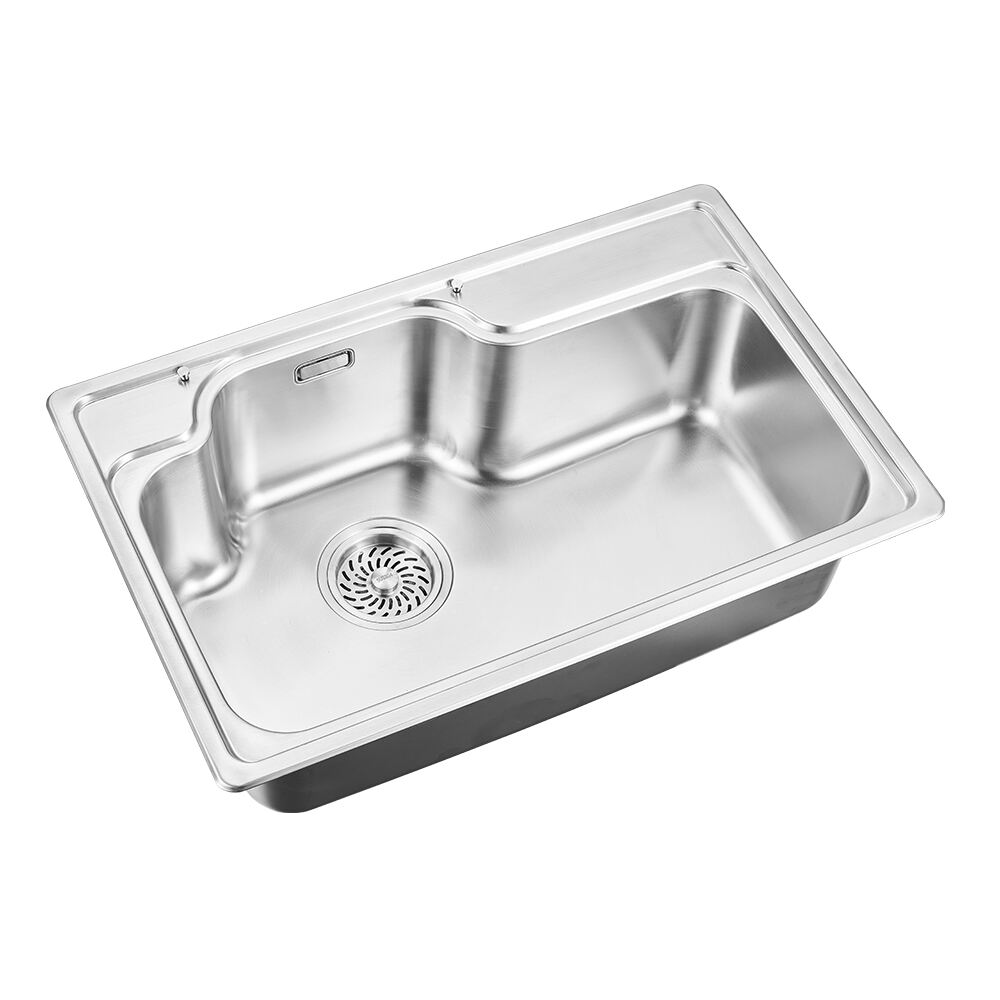كيفية تحسين أحواض الفولاذ المقاوم للصدأ لوظائف المطبخ
تتطلب المطابخ الحديثة، سواء في المنازل أو المطاعم أو المرافق المؤسسية، المتانة والكفاءة والنظافة في كل عنصر من عناصر تصميمها. ومن بين جميع الوصلات، يظل حوض الفولاذ المقاوم للصدأ واحدًا من أكثرها أهمية واستخدامًا متكررًا. ويُعرف هذا الحوض بأدائه الطويل الأمد ومظهره النظيف، حيث لا يحسّن عمليات المطبخ فحسب، بل يدعم أيضًا النظافة والتدفق الجيد للعمل. يناقش هذا المقال لماذا أحواض الفولاذ المقاوم للصدأ يُعد خيارًا موثوقًا به للمطابخ التجارية والسكنية على حد سواء، وكيف تُحقق ميزاته قيمة طويلة الأمد.
قوة المواد ومتانتها
المقاومة للتآكل والبقع
تُعتبر مقاومة المغاسل الفولاذية للصدأ والبقع واحدة من أبرز خصائصها المُميزة. في بيئة المطبخ، قد يؤدي التعرض المستمر للماء والأطعمة الحمضية والمنظفات الكيميائية إلى تدهور المواد بسرعة. لكن الفولاذ المقاوم للصدأ يمتلك خاصية طبيعية تحميه من الصدأ ويحافظ على مظهره حتى بعد سنوات من الاستخدام. يُشكّل محتوى الكروم الموجود في الفولاذ المقاوم للصدأ طبقةً غير نشطة تحميه من الأكسدة، مما يعني أنه لا يفقد لونه بسهولة أو يتفتت. هذا يجعله خيارًا مثاليًا للبيئات التي تتعامل مع الأغذية حيث تُعد النظافة والمظهر مهمين. حتى عند الخضوع لفرك يومي أو التعرض للسوائل الحمضية، فإن مغسلة الفولاذ المقاوم للصدأ عالية الجودة تبقى سليمة وقوية وظيفيًا.
المقاومة للصدمات والخدوش
الدُّرِيَّة لا تعني فقط مقاومة التآكل. فبالإضافة إلى ذلك، تُظهر أحواض الفولاذ المقاوم للصدأ أداءً استثنائيًا تحت الضغط البدني. فهي قادرة على تحمل سقوط الأدوات والمِلاعق والقدور دون أن تتشقق أو تتقشر، وهي مشكلة شائعة لدى الخيارات المصنوعة من البورسلين أو السيراميك. ويجعل هذا من الحوض الفولاذي المقاوم للصدأ خيارًا مثاليًا للمطابخ التجارية حيث تكون الأنشطة المُطبخية مكثفة وسريعة. حتى في المطابخ المنزلية، فإن متانة الحوض الفولاذي المقاوم للصدأ تعني الحاجة إلى استبداله بشكل أقل وبالتالي تقل تكاليف الصيانة على المدى الطويل. كما يوفر بعض خيارات الفولاذ المقاوم للصدأ ذات العيار الأعلى مقاومة إضافية ضد الكهوف، مما يضمن متانة وقيمة على المدى الطويل.

مزايا الصيانة والنظافة
التنظيف سهل والصيانة قليلة
تُعتبر أحواض الفولاذ المقاوم للصدأ من أجهزة المطبخ الأسهل في التنظيف. لا تسمح أسطحها الملساء غير المسامية ببقاء جزيئات الطعام أو الرطوبة، مما يجعلها أكثر نظافة بحكم طبيعتها. يُعد مسحها بسرعة بواسطة إسفنجة ناعمة ومنظف خفيف كافيًا في كثير من الأحيان لاستعادة اللمعان وإزالة معظم البقع. وبما أن حوض الفولاذ المقاوم للصدأ لا يحتاج إلى منظفات خاصة أو معاجين تلميع، يكون الصيانة الروتينية بسيطًا واقتصاديًا. وفي مطابخ المطاعم المزدحمة، يُترجم هذا السهولة في الصيانة إلى توفير الوقت والجهد. إذ يسمح التنظيف السريع للموظفين بالتركيز على إعداد الطعام بدلًا من تنظيف الأجهزة، مما يحسّن من كفاءة سير العمل ومعايير النظافة.
مقاومة البكتيريا والعفن
في بيئات تقديم الطعام، لا تُقبل المساومة على النظافة. تتميز أحواض الفولاذ المقاوم للصدأ بمقاومة متفوقة للبكتيريا والعفن مقارنةً بالأحواض المصنوعة من مواد مسامية مثل الجرانيت أو خامات الخشب المركب. وبما أن سطح حوض الفولاذ المقاوم للصدأ لا يسمح بدخول الماء أو المواد العضوية إليه، فإن خطر تراكم الكائنات الدقيقة يكون أقل. ويعتبر هذا الأمر بالغ الأهمية في المطابخ التي يتم فيها غسل اللحوم النيئة والخضروات وغيرها من المواد القابلة للتلف بشكل متكرر. كما أن سهولة تعقيم حوض الفولاذ المقاوم للصدأ تسهم في الامتثال لمتطلبات سلامة الأغذية وتوفر للمستخدمين راحة البال بأن أسطح العمل تظل نظيفة وآمنة طوال اليوم.
المرونة في التصميم والتثبيت
التوافق مع مختلف أسطح الطاولات
الحوض المصنوع من الفولاذ المقاوم للصدأ هو أحد العناصر الأكثر تنوعاً من حيث الدمج في التصميم. سواء كانت مطبخك تحتوي على سطح عمل من الحجر أو القشرة أو السطح الصلب، يمكن تركيب حوض من الفولاذ المقاوم للصدأ بشكل سلس. تتيح هذه المرونة للمصممين وأصحاب المنازل التركيز على المظهر الجمالي العام للمطبخ دون التفريط في الوظائف. تتوفر أنماط التركيب من تحت السطح ومن فوق السطح ومن مستوى السطح مع خيارات من الفولاذ المقاوم للصدأ، مما يمنح المستخدمين مجموعة من الخيارات التي تتماشى مع تصميمهم واحتياجاتهم الخاصة. كما تساعد خاصية الانعكاس في الحوض المصنوع من الفولاذ المقاوم للصدأ على جعل المطابخ الصغيرة تبدو أكثر إشراقاً واتساعاً.
مدى الأحجام والتكوينات
تتوفر أحواض المطبخ المصنوعة من الفولاذ المقاوم للصدأ بأنواع وأحجام مختلفة تلبي احتياجات المطابخ السكنية الصغيرة والمنشآت التجارية الكبيرة على حد سواء. سواء كنت بحاجة إلى حوض واحد لمساحات محدودة أو مجموعة من ثلاثة أحواض لأعمال الغسيل والتحضير الشاقة، فهناك بالتأكيد نموذج مناسب من أحواض الفولاذ المقاوم للصدأ يناسب متطلباتك. تجعل هذه المرونة في التصميم من هذه الأحواض خياراً شائعاً بين الطهاة ومصممي المطابخ وأصحاب المنازل على حد سواء. كما أن توفر خيارات مختلفة من حيث العمق والشكل يسهم في الاستخدام المريح، مما يسمح للمستخدمين بتنظيف القطع الكبيرة دون انسكاب المياه أو الشعور بعدم الراحة. هذا الاختيار الواسع يجعل من حوض الفولاذ المقاوم للصدأ خياراً عملياً لأي تصميم مطبخ تقريباً.
كفاءة التكلفة والقيمة طويلة الأجل
تكلفة امتلاك أقل بشكل عام
على الرغم من أن بعض موديلات الأحواض المصنوعة من الفولاذ المقاوم للصدأ قد تكون ذات تكلفة أولية أعلى مقارنة بالبدائل الأساسية، إلا أن عمرها الطويل واحتياجاتها المحدودة من الصيانة تجعلها في كثير من الأحيان الخيار الأكثر اقتصادية على المدى الطويل. وعلى عكس الأحواض الخزفية أو المركبة التي قد تحتاج إلى إصلاحات أو استبدال خلال بضع سنوات، يمكن للحوض المصنوع من الفولاذ المقاوم للصدأ أن يدوم لعقود إذا تمت صيانته بشكل صحيح. وينتج عن هذا الأداء الطويل أمداً تكلفة إجمالية أقل للامتلاك، خاصة في البيئات ذات الاستخدام الكثيف مثل المطاعم أو صالات الطعام. وعند أخذ مواد التنظيف والإصلاحات والفترات المتوقفة عن العمل بعين الاعتبار، يظهر الحوض المصنوع من الفولاذ المقاوم للصدأ باستمرار كاستثمار أكثر ذكاءً.
خيار مستدام بيئياً
الفولاذ المقاوم للصدأ هو مادة قابلة لإعادة التدوير بنسبة 100٪، مما يجعل الأحواض المصنوعة منه خيارًا مستدامًا للمستهلكين الواعين للبيئة. تُصنع العديد من أحواض الفولاذ المقاوم للصدأ من مواد معاد تدويرها، وعند نهاية عمرها الافتراضي، يمكن إعادة تدويرها مرة أخرى دون فقدان الجودة. هذه الاستدامة الدورية المغلقة تمثل ميزة كبيرة في عصر أصبحت فيه الممارسات الخضراء في البناء وكفاءة المواد أكثر أهمية. بالنسبة للشركات التي ترغب في تعزيز عملياتها الصديقة للبيئة أو الحصول على شهادة LEED، فإن اختيار حوض من الفولاذ المقاوم للصدأ هو خطوة في الاتجاه الصحيح. فهو لا يدعم الأهداف البيئية فحسب، بل يعزز أيضًا صورة الشركة كشركة مسؤولة.
خصائص التحكم في الضوضاء والراحة
تقنيات تقليل الصوت
أحد المفاهيم الخاطئة الشائعة هو أن المغسلات الفولاذية المقاومة للصدأ صاخبة أثناء الاستخدام. في حين أن هذا قد يكون صحيحًا بالنسبة للنماذج الأولى ، فإن حوضات الفولاذ المقاوم للصدأ اليوم غالباً ما تتضمن ميزات خفيفة للصوت. قد تشمل هذه المواد وسائد المطاط أو طبقات عازلة أو تصاميم تخفف الاهتزازات التي تقلل بشكل كبير من الضوضاء أثناء الغسيل أو الشطف. هذه الميزة مفيدة بشكل خاص في تصاميم المطبخ المفتوحة حيث تقليل الضوضاء هو أولوية. في المطبخ التجاري، يقلل الضجيج يساهم في بيئة أكثر هدوءاً وكفاءة. الراحة المضافة للعمليات الهادئة تعزز رضا المستخدم وتدعم تركيز أفضل بين الموظفين.
تحسينات في التصميم الأرجونومي
تم تصميم أحواض الفولاذ المقاوم للصدأ الحديثة مع التركيز على راحة المستخدم. من أحواض ذات قواعد مائلة تحسن تصريف المياه إلى زوايا مستديرة تسهل التنظيف، كل ميزة في التصميم محسنة لتسهيل الاستخدام. تساعد الأحواض الأعمق في احتواء رش المياه، بينما تُسهم الإكسسوارات المدمجة مثل المصفاة وألواح التقطيع وأرفف التجفيف في تبسيط سير العمل. لا تُحسّن هذه الميزات الجسدية تجربة المستخدم فحسب، بل تقلل أيضًا من الإجهاد الجسدي أثناء المهام المتكررة. في البيئات التي يعمل فيها الموظفون لفترات طويلة، تجعل هذه الإضافات في التصميم الحوض الفولاذي المقاوم للصدأ أداة وظيفية وداعمًا لعادات عمل أكثر صحة.
الجاذبية البصرية والمظهر الاحترافي
مظهر نظيف وأنيق لا يتأثر بالزمن
يوفر حوض الفولاذ المقاوم للصدأ مظهرًا أنيقًا وحديثًا يتناسب مع مجموعة واسعة من أنماط المطابخ. تتناغم لمسة المعادن المحايدة الخاصة به بشكل جيد مع التصاميم المعاصرة والصناعية وحتى التقليدية. وعلى عكس الأسطح العصرية التي قد تخرج من الموضة، فإن مظهر حوض الفولاذ المقاوم للصدأ كلاسيكي ودائم. وهو يمنح مظهرًا احترافيًا يقدّره الكثير من الطهاة وربات البيوت على حد سواء. كما يحافظ السطح على جاذبيته حتى مع الاستخدام المنتظم، حيث يكتسب لمسة داكنة خفيفة بمرور الوقت تُحسّن خصائصه البصرية. ولأصحاب المنازل والمصممين الباحثين عن عنصر أنيق ودائم في المطبخ، يُعد الفولاذ المقاوم للصدأ خيارًا مميزًا.
يعكس الضوء ويوسع الإحساس بالمساحة
إن طبيعة الانعكاس الخاصة بالفولاذ المقاوم للصدأ لا تضيف اللمعان فقط إلى المطبخ، بل تخلق أيضًا إحساسًا بأن المساحة أوسع مما هي عليه. ويعتبر هذا مفيدًا بشكل خاص في المطابخ الصغيرة أو المناطق المغلقة التي يكون فيها الاستفادة القصوى من الإضاءة أمرًا بالغ الأهمية. ويمكن أن يساهم حوض المطبخ المصنوع من الفولاذ المقاوم للصدأ، عند وضعه في مكان استراتيجي بالقرب من نافذة أو تحت إضاءة موجهة، في تعزيز جو الغرفة بشكل عام. فسطحه الملساء تعمل كأنها مرآة تقريبًا، وتعكس الضوء في أرجاء المكان وتساهم في بيئة أكثر نظافة واتساعًا. ويعتبر هذا الفائدة التصميمية الدقيقة ولكن الفعالة تحسينًا لكل من الشكل والوظيفة، مما يثبت أن أحواض المطبخ المصنوعة من الفولاذ المقاوم للصدأ تتجاوز مجرد الفائدة العملية، بل أنها ترفع من تجربة المطبخ ككل.
الأسئلة الشائعة
ما هو المعيار الأفضل لحوض المطبخ المصنوع من الفولاذ المقاوم للصدأ؟
في معظم الاستخدامات التجارية والسكنية، يوفر حوض مصنوع من الفولاذ المقاوم للصدأ بسماكة 16 أو 18 قياسًا أفضل توازن بين المتانة وتقليل الضوضاء.
هل أحواض المطبخ المصنوعة من الفولاذ المقاوم للصدأ مناسبة لمناطق المياه الجافة؟
نعم، تتميز أحواض الفولاذ المقاوم للصدأ بمقاومة عالية للرواسب المعدنية ويمكن تنظيفها بسهولة باستخدام الخل أو منظف خفيف لإزالة أي تراكمات.
هل تتعرض أحواض الفولاذ المقاوم للصدأ للانبعاج بسهولة؟
أحواض الفولاذ المقاوم للصدأ ذات الجودة العالية، وخاصة تلك التي تحتوي على أرقام قياسية أقل، تتميز بمقاومة كبيرة للانبعاجات الناتجة عن الاستخدام الطبيعي في المطبخ.
هل يمكنني تركيب حوض من الفولاذ المقاوم للصدأ بنفسي؟
تتميز العديد من أحواض الفولاذ المقاوم للصدأ بأنها مناسبة للاستخدام المنزلي (DIY)، ولكن بالنسبة للنماذج المثبتة تحت الحوض أو التكوينات المعقدة، يُوصى بالاستعانة بفني محترف للتركيب.



